
Aptera in the 10th edition of Systema Naturae
Encyclopedia
In the 10th edition of Systema Naturae, Carl Linnaeus classified the arthropod
s, including insect
s, arachnid
s and crustacean
s, among his class "Insecta". Wingless arthropods were brought together under the name Aptera.
Lepisma (silverfish
Podura (springtail

Termes (termite
Pediculus (lice
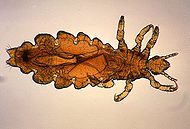
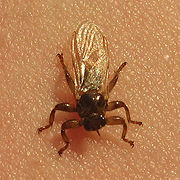
Pulex (flea
Acarus (mite
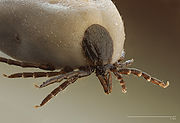

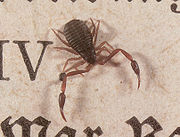
Phalangium (harvestmen
Aranea (spider
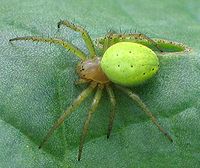
Scorpio (scorpion
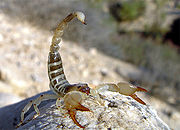
Brachyuri (crab
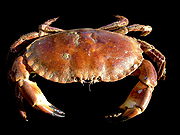
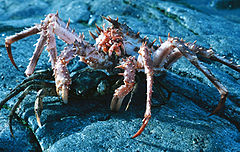
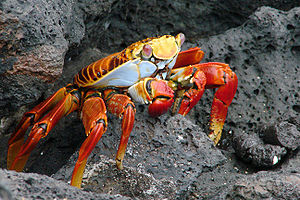
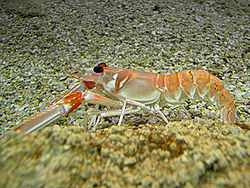
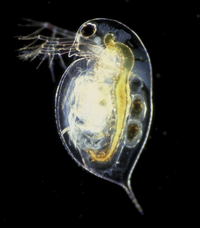
Oniscus (woodlice
.jpg)
Scolopendra (centipede
Julus (millipede
Arthropod
An arthropod is an invertebrate animal having an exoskeleton , a segmented body, and jointed appendages. Arthropods are members of the phylum Arthropoda , and include the insects, arachnids, crustaceans, and others...
s, including insect
Insect
Insects are a class of living creatures within the arthropods that have a chitinous exoskeleton, a three-part body , three pairs of jointed legs, compound eyes, and two antennae...
s, arachnid
Arachnid
Arachnids are a class of joint-legged invertebrate animals in the subphylum Chelicerata. All arachnids have eight legs, although in some species the front pair may convert to a sensory function. The term is derived from the Greek words , meaning "spider".Almost all extant arachnids are terrestrial...
s and crustacean
Crustacean
Crustaceans form a very large group of arthropods, usually treated as a subphylum, which includes such familiar animals as crabs, lobsters, crayfish, shrimp, krill and barnacles. The 50,000 described species range in size from Stygotantulus stocki at , to the Japanese spider crab with a leg span...
s, among his class "Insecta". Wingless arthropods were brought together under the name Aptera.
Lepisma (silverfishSilverfishLepisma saccharina, frequently called silverfish, fishmoths, carpet sharks or paramites, are small, wingless insects in the order Thysanura...
)
- Lepisma saccharina
- Lepisma terrestris – named after an injured specimen of Lepisma saccharina
Podura (springtailSpringtailSpringtails form the largest of the three lineages of modern hexapods that are no longer considered insects...
s)

- Podura viridis – Sminthurus viridisSminthurus viridisSminthurus viridis, the clover springtail or lucerne flea, is a hexapod belonging to the order Collembola . It is bright green with a roughly spherical body and often swarms in large numbers on living plants, especially Fabaceae including alfalfa...
- Podura atra – Dicyrtoma atra
- Podura fusca – Allacma fuscaAllacma fuscaAllacma fusca is a species of springtail. This species is endemic to western areas of Continental Europe and the British Isles....
- Podura plumbea – Pogonognathellus flavescens
- Podura nivalis – Entomobrya nivalis
- Podura arborea – Vertagopus arboreus
- Podura cincta – Orchesella cinctaOrchesella cinctaOrchesella cincta is a species of springtail present in North America and Europe. They average in length....
- Podura aquatica – Podura aquaticaPodura aquaticaThe water springtail is a species of springtail, one of only four described species in the family Poduridae. It is an abundant species with a Holarctic distribution....
- Podura fimetaria – Folsomia fimetaria
- Podura ambulans – Onychiurus ambulans
Termes (termiteTermiteTermites are a group of eusocial insects that, until recently, were classified at the taxonomic rank of order Isoptera , but are now accepted as the epifamily Termitoidae, of the cockroach order Blattodea...
s and PsocopteraPsocopteraPsocoptera are an order of insects that are commonly known as booklice, barklice or barkflies. They first appeared in the Permian period, 295–248 million years ago. They are often regarded as the most primitive of the hemipteroids. Their name originates from the Greek word psokos meaning...
)
- Termes fatale – Termes fatalis
- Termes pulsatorium – Trogium pulsatorium
- Termes fatidicum – Lachesilla pedicularia
Pediculus (liceLouseLice is the common name for over 3,000 species of wingless insects of the order Phthiraptera; three of which are classified as human disease agents...
)


- Pediculus humanus – head louseHead louseThe head louse is an obligate ectoparasite of humans. Head lice are wingless insects spending their entire life on human scalp and feeding exclusively on human blood...
- Pediculus pubis – crab louseCrab louseCrab lice are parasitic insects notorious for infesting human pubic hair. The species may also live on other areas with hair, including the eyelashes. They feed exclusively on blood...
- Pediculus ricinoides
- Pediculus vespertilionis – [suppressed]
- Pediculus suis – Haematopinus suis
- Pediculus porcelli – [nomen nudum]
- Pediculus cameli – Microthoracius cameli
- Pediculus cervi – Lipoptena cervi
- Pediculus ovis – [nomen nudum]
- Pediculus bovis – Bovicola bovis
- Pediculus vituli – Linognathus vituli
- Pediculus equi – [nomen nudum]
- Pediculus asini – Haematopinus asini
- Pediculus tinnunculi – Laemobothrion tinnunculi
- Pediculus corvi – Philopterus corvi
- Pediculus infausti
- Pediculus picae – Myrsidea picae
- Pediculus cygni – Ornithobius cygni
- Pediculus anseris – Anaticola anseris
- Pediculus moschatae – Acidoproctus moschatae
- Pediculus querquedulae – Trinoton querquedulae
- Pediculus sternae – Saemundssonia sternae
- Pediculus plataleae – Ardeicola plataleae
- Pediculus ardeae – Ardeicola ardeae
- Pediculus gruis – Esthiopterum gruis
- Pediculus ciconiae – Ardeicola ciconiae
- Pediculus charadrii – Quadraceps charadrii
- Pediculus fulicae – Incidifrons fulicae
- Pediculus recurvirostrae – Cirrophthirius recurvirostrae
- Pediculus haematopi – Saemundssonia haematopi
- Pediculus pavonis – Goniodes pavonis
- Pediculus meleagridis – Chelopistes meleagridis
- Pediculus gallinae – Menopon gallinae
- Pediculus caponis – Lipeurus caponis
- Pediculus tetraonis – Goniodes tetraonis
- Pediculus lagopi – Goniodes lagopi
- Pediculus columbae – Columbicola columbae
- Pediculus pari
- Pediculus apis
Pulex (fleaFleaFlea is the common name for insects of the order Siphonaptera which are wingless insects with mouthparts adapted for piercing skin and sucking blood...
s)
- Pulex irritans – human fleaHuman fleaThe human flea, Pulex irritans, is a cosmopolitan flea species that has, in spite of the common name, a wide host spectrum. It is one of six species in the genus Pulex; the other five are all confined to the Nearctic and Neotropical regions...
- Pulex penetrans – Chigoe fleaChigoe fleaThe chigoe flea or jigger is a parasitic arthropod found in most tropical and sub-tropical climates, not to be confused with the larval form of Trombiculidae found in more temperate climates. In Brazil, the parasite is referred to as bicho-de-pé . At 1 mm long, the chigoe flea is the smallest...
Acarus (miteMiteMites, along with ticks, are small arthropods belonging to the subclass Acari and the class Arachnida. The scientific discipline devoted to the study of ticks and mites is called acarology.-Diversity and systematics:...
s & tickTickTicks are small arachnids in the order Ixodida, along with mites, constitute the subclass Acarina. Ticks are ectoparasites , living by hematophagy on the blood of mammals, birds, and sometimes reptiles and amphibians...
s)



- Acarus elephantinus
- Acarus aegyptius – Hyalomma aegyptium
- Acarus reduvius, Acarus ricinus & Acarus sanguisugus – Ixodes ricinusIxodes ricinusIxodes ricinus, the castor bean tick, is a chiefly European species of hard-bodied tick. It may reach a length of when engorged with a blood meal, and can transmit both bacterial and viral pathogens such as the causative agents of Lyme disease and tick-borne encephalitis.-Description:In common...
- Acarus americanus – Amblyomma americanumAmblyomma americanumAmblyomma americanum, or lone star tick, is a species of tick in the genus Amblyomma. It's average length is 1/4 inch.-Distribution:...
- Acarus cancroides – Chelifer cancroides
- Acarus scorpioides – Cordylochernes scorpioides
- Acarus crassipes – Pergamasus crassipes
- Acarus passerinus – Analges passerinus
- Acarus motatorius – Linopodes motatorius
- Acarus aphidioides – Asca aphidoides
- Acarus coleoptratus – Archipteria coleoptrata
- Acarus telarius – Eotetranychus telarius
- Acarus siro – flour miteFlour MiteThe flour mite, Acarus siro, is a pest of stored grains. An older name is Tyroglyphus farinae. It is one of many species of grain and flour mites....
- Acarus exulcerans
- Acarus geniculatus – Lucoppia geniculata
- Acarus aquaticus – Limnochares aquaticus
- Acarus holosericeus – Trombidium holosericeumTrombidium holosericeumTrombidium holosericeum is a species of mite in the genus Trombidium, commonly called the velvet mite.-Description:This species is one of the largest mites in northern temperate zones, with a body length of about 4 mm. The soft, brightly red body is covered with fine hairs, giving it a velvety...
- Acarus baccarum – Anystis baccarum
- Acarus muscarum – Myianoetus muscarum
- Acarus batatas – Eutrombicula batatasEutrombicula batatasEutrombicula batatas is a species of chigger .Host species include:Didelphimorphia*Didelphis marsupialis in Venezuela*Lutreolina crassicaudata in Venezuela*Marmosa robinsoni in Venezuela...
- Acarus gymnopterorum
- Acarus coleoptratorum – Parasitus coleoptratorum
- Acarus rupestris – Erythraeus rupestris
- Acarus longicornis – Bdella longicornis
- Acarus littoralis – Neomolgus littoralis
- Acarus fungorum – Humerobates rostrolamellatus
- Acarus scaber – [species inquirenda], perhaps Camisia biverrucata
- Acarus salicinus – Anystis salicinus
- Acarus croceus – [species inquirenda], TydeusTydeus (mite)Tydeus is a genus of mites belonging to the family Tydeidae. These are small, usually white, mites with soft bodies covered in striations and each leg terminating in two claws.-References:*...
sp.
Phalangium (harvestmenOpilionesOpiliones are an order of arachnids commonly known as harvestmen. , over 6,400 species of harvestmen have been discovered worldwide, although the real number of extant species may exceed 10,000. The order Opiliones can be divided into four suborders: Cyphophthalmi, Eupnoi, Dyspnoi and Laniatores...
, Amblypygi, Thelyphonida)
- Phalangium opilioPhalangium opilioPhalangium opilio is "the most widespread species of harvestman in the world", occurring natively in Europe, and much of Asia, and having been introduced to North America, North Africa and New Zealand...
- Phalangium caudatum – Thelyphonus caudatus
- Phalangium reniforme – Phrynus ceylonicus
Aranea (spiderSpiderSpiders are air-breathing arthropods that have eight legs, and chelicerae with fangs that inject venom. They are the largest order of arachnids and rank seventh in total species diversity among all other groups of organisms...
s)

- Aranea diadema – European garden spiderEuropean garden spiderThe European garden spider, diadem spider, cross spider, or cross orbweaver is a very common and well-known orb-weaver spider in Europe and parts of North America, in a range extending from New England and the Southeast to California and the northwestern United States and adjacent parts of...
- Aranea reticulata – Metellina segmentataMetellina segmentataMetellina segmentata is a spider in the Tetragnathidae family with a Palaearctic distribution. It has also been introduced to Canada.Adults can be found from August to October. These spiders prefer open habitats and are amongst the most frequent orb-weaving spiders.The web has no threads at its...
- Aranea cucurbitina – cucumber green spider
- Aranea calycina – Misumena vatiaMisumena vatiaMisumena vatia is a species of crab spider with holarctic distribution. In North America, where it is the largest and best-known flower spider, it is called the goldenrod crab spider or flower spider, because it is commonly found hunting in goldenrod sprays in the autumn.Young males in the early...
- Aranea bipunctata – Steatoda bipunctataSteatoda bipunctataSteatoda bipunctata is a species of cob-web spider, of the genus Steatoda, in the family Theridiidae.It is common in North America and Europe and may be found in proximity to human structures, such as basements or sheds. A nickname for this arachnid is the Rabbit Hutch Spider, since rabbit hutches...
- Aranea arundinacea – Dictyna arundinacea
- Aranea angulata – Araneus angulatusAraneus angulatusAraneus angulatus is a species of orb-weaving spider found in the Palaearctic. It resembles the European garden spider, Araneus diadematus, but has distinctive tubercles on its abdomen...
- Aranea domestica – Tegenaria domestica
- Aranea lineata – Stemonyphantes lineatus
- Aranea riparia & Aranea labyrinthica – Agelena labyrinthicaAgelena labyrinthicaAgelena labyrinthica is a species of spider in the family Agelenidae, which contains 1146 species of funnel-web spiders. It is a widespread species in Europe, where there are 180 species, and in Central Europe, where there are 30 species currently known....
- Aranea redimita – Enoplognatha ovataEnoplognatha ovataEnoplognatha ovata is a species of spider belonging to the family Theridiidae. It is native to Europe and has also been introduced to North America....
- Aranea corollata – [nomen dubium]
- Aranea fumigata – Pardosa amentata
- Aranea montana – Linyphia triangularis
- Aranea notata – Phylloneta sisyphia
- Aranea rufipes – Gongylidium rufipes
- Aranea nocturna – Callilepis nocturna
- Aranea extensa – Tetragnatha extensaTetragnatha extensaTetragnatha extensa is a species of spider found across the Northern Hemisphere. It has an elongate body, up to long, and adopts a straight line posture when alarmed. It lives on low vegetation in damp areas, and feeds on flying insects which it catches in its web.-Description:T. extensa has an...
- Aranea fimbriata, Aranea palustris, & Aranea virescens – raft spiderRaft spiderThe raft spider, Dolomedes fimbriatus, is a European spider of the family Pisauridae. The raft spider is one of the two largest spiders in the United Kingdom...
- Aranea sexpunctata – Nuctenea umbraticaNuctenea umbraticaThe Walnut Orb-Weaver Spider is a spider of the Araneidae family.-Description:The walnut orb-weaver spider is very wide and flattened, with a leathery skin. Its color ranges from red brown and grey brown to black with a dark, yellowish to yellow-greenish leaf-like fleckled marking on its...
- Aranea flavissima
- Aranea quadripunctata – Scotophaeus quadripunctatus
- Aranea holosericea – Clubiona pallidula
- Aranea senoculata – Segestris senoculata
- Aranea avicularia – pinktoe tarantulaPinktoe TarantulaThe pinktoe tarantula, Avicularia avicularia, is a species of tarantula native to South America, Costa Rica to Brazil, and the southern Caribbean...
- Aranea ocellata – [nomen dubium]
- Aranea tarantula – Lycosa tarantulaLycosa tarantulaThe tarantula wolf spider or just tarantula is a wolf spider found in southern Europe, especially in Italy and near the city of Taranto...
- Aranea scenica – zebra spiderZebra spiderThe zebra spider, Salticus scenicus, is a common household jumping spider. Like other jumping spiders, it does not build a web. It uses its four pairs of large eyes to locate prey and its jumping ability to pounce and capture it. Zebra spiders are often noted for their awareness of humans...
- Aranea truncorum – [nomen dubium]
- Aranea rupestris – Evarcha falcataEvarcha falcataEvarcha falcata is a species of jumping spider with Palaearctic distribution.Females are about 7 mm long, males slightly shorter.Two subspecies are currently recognised:* Evarcha falcata nigrofusca...
- Aranea aquatica – diving bell spiderDiving bell spiderThe diving bell spider or water spider, Argyroneta aquatica, is the only species of spider known to live entirely under water.Argyroneta aquatica is found in northern and central Europe and northern Asia up to latitude 62°N. It is the only spider known to spend its whole life under water...
- Aranea saccata – Pardosa amentata
- Aranea viatica – Xysticus cristatus
- Aranea levipes – Philodromus margaritatus
- Aranea cancriformis – Gasteracantha cancriformisGasteracantha cancriformisGasteracantha cancriformis is a species of spider.Females are long and wide...
- Aranea spinosa – Micrathena spinosa
Scorpio (scorpionScorpionScorpions are predatory arthropod animals of the order Scorpiones within the class Arachnida. They have eight legs and are easily recognized by the pair of grasping claws and the narrow, segmented tail, often carried in a characteristic forward curve over the back, ending with a venomous stinger...
s)

- Scorpio maurusScorpio maurusScorpio maurus is a species of North African and Middle Eastern scorpion, also known as the Large-clawed Scorpion or Israeli gold scorpion.This is a small/medium sized scorpion from the family Scorpionidae...
- Scorpio afer – [nomen dubium]
- Scorpio americus – [nomen dubium]
- Scorpio europaeus – [suppressed]
- Scorpio australis – Androctonus australis
Brachyuri (crabCrabTrue crabs are decapod crustaceans of the infraorder Brachyura, which typically have a very short projecting "tail" , or where the reduced abdomen is entirely hidden under the thorax...
s)



- Cancer cursor – Ocypode cursor
- Cancer raninus – Ranina raninaRanina raninaRanina ranina, the red frog crab or spanner crab, is a species of edible crab, the only extant species in its genus.-Description:...
- Cancer mutus – Tetralia muta
- Cancer minutus – Planes minutus
- Cancer ruricola – Gecarcinus ruricolaGecarcinus ruricolaGecarcinus ruricola is a species of terrestrial crab. It is the most terrestrial of the Caribbean land crabs, and is found from western Cuba across the Antilles as far east as Barbados. Common names for G...
- Cancer vocans – Uca vocansUca vocansUca vocans is a species of fiddler crab. It is found across the Indo-Pacific from the Red Sea, Zanzibar and Madagascar to Indonesia and the central Pacific Ocean. It lives in burrows up to deep. Several forms of U. vocans have been recognised, with their authors often granting them the taxonomic...
- Cancer craniolaris – Leucosia craniolaris
- Cancer philargius – Calappa philargius
- Cancer rhomboides – Goneplax rhomboidesGoneplax rhomboidesGoneplax rhomboides is a species of crab. It is known by the common name angular crab because of its angular carapace. Although it is also called the square crab, its shell is in fact more trapezoidal than square...
- Cancer maculatus – Carpilius maculatus
- Cancer pelagicus – Portunus pelagicusPortunus pelagicusPortunus pelagicus, also known as the flower crab, blue crab, blue swimmer crab, blue manna crab or sand crab, is a large crab found in the intertidal estuaries of the Indian and Pacific Oceans and the Middle-Eastern coast of the Mediterranean Sea. The name "flower crab" is used in east Asian...
- Cancer nucleus – Ilia nucleus
- Cancer lactatus
- Cancer maenas – Carcinus maenasCarcinus maenasCarcinus maenas is a common littoral crab, and an important invasive species, listed among the 100 "world's worst alien invasive species". It is native to the north-east Atlantic Ocean and Baltic Sea, but has colonised similar habitats in Australia, South Africa, South America and both Atlantic and...
- Cancer depurator – Liocarcinus depuratorLiocarcinus depuratorLiocarcinus depurator, sometimes called the harbour crab or sandy swimming crab, is a species of crab found in the North Sea, Atlantic Ocean, Mediterranean Sea and Black Sea. It grows up to in width and long, and it can be distinguished from other crabs, such as the shore crab Carcinus maenas by...
- Cancer feriatus – Charybdis feriata
- Cancer granulatus – Calappa granulata
- Cancer pagurus
- Cancer chabrus – Plagusia chabrus
- Cancer araneus – great spider crabGreat spider crabThe great spider crab, Hyas araneus, is a species of crab found in Atlantic waters and the North Sea, usually below the tidal zone.In 2003 it was discovered around the Antarctic Peninsula apparently transported by human agency....
- Cancer cuphaeus
- Cancer muscosus – Pisa muscosa
- Cancer personata – Dromia personataDromia personataDromia personata is a species of crab found in the North Sea, the Mediterranean Sea, and connecting parts of the northeastern Atlantic Ocean. It grows up to a carapace length of , and lives mainly from the lower shore to a depth of , or occasionally to , and often in caves...
- Cancer pinnotheres – Nepinnotheres pinnotheres
- Cancer maja – Lithodes majaLithodes majaLithodes maja is a species of king crab which occurs in the colder waters of Europe and North America. It is found along entire coast of Norway, the northern half of the British Isles, and around the Faroe Islands, Iceland, Svalbard and off south-eastern Greenland. In Canada, it is found from...
- Cancer longimanus – Parthenope longimanus
- Cancer horridus – Daldorfia horrida
- Cancer cristatus – Micippa cristata
- Cancer superciliosus – Criocarcinus superciliosus
- Cancer cornutus – [nomen dubium]
- Cancer longipes – Phalangipus longipes
- Cancer spinifer – [nomen dubium]
- Cancer cruentatus – Lissa chiragra
- Cancer hepaticus – Calappa hepaticaCalappa hepaticaCalappa hepatica is a common benthic crab of tropical and subtropical parts of the Indian and Pacific Oceans and the Red Sea. It is also known as the box crab, shame-faced crab or the tortoise crab, the last two names referring to the animal's appearance, with its two chelipeds being used to...
- Cancer calappa – Calappa calappa
- Cancer grapsus – Grapsus grapsusGrapsus grapsusThe crab Grapsus grapsus is one of the most common crabs along the western coast of the Americas. It is known variously as "red rock crab", "abuete negro", and, together with other crabs such as Percnon gibbesi, as "Sally Lightfoot"...
- Cancer aeneus – Zosimus aeneusZosimus aeneusZosimus aeneus is a species of crab that lives on coral reefs in the Indo-Pacific from East Africa to Hawaii. It grows to a size of and has distinctive patterns of brownish blotches on a paler background. It is potentially lethal due to the presence in its flesh and shell of the neurotoxins...
- Cancer punctatus – Persephona punctata
- Cancer dorsipes – Notopus dorsipes
- Cancer symmysta – Albunea symmysta
Macrouri

- Cancer bernhardus – Pagurus bernhardusPagurus bernhardusPagurus bernhardus is the common marine hermit crab of Europe's Atlantic coasts. It is sometimes referred to as the common hermit crab or soldier crab. It is about long, and is found in both rocky and sandy areas, from the Arctic waters of Iceland, Svalbard and Russia as far south as southern...
- Cancer diogenes – Petrochirus diogenesPetrochirus diogenesPetrochirus diogenes is a giant marine hermit crab. This species lives in the Caribbean Sea, and often inhabits conch shells. This species of hermit crab is large enough that it can inhabit a fully grown shell of Eustrombus gigas. It will attack and eat a conch, thus obtaining a meal and a shell...
- Cancer gammarus – European lobsterEuropean lobsterHomarus gammarus, known as the European lobster or common lobster, is a species of clawed lobster from the eastern Atlantic Ocean, Mediterranean Sea and parts of the Black Sea. It is closely related to the American lobster, H. americanus. It may grow to a length of and a mass of , and bears a...
- Cancer astacus – Astacus astacusAstacus astacusAstacus astacus, the European crayfish, noble crayfish or broad-fingered crayfish, is the most common species of crayfish in Europe, and a traditional foodstuff. Like other crayfish, Astacus astacus is restricted to fresh water, living only in unpolluted streams, rivers and lakes...
- Cancer carcinus – Macrobrachium carcinus
- Cancer pennaceus
- Cancer squilla – Palaemon adspersusPalaemon adspersusPalaemon adspersus is a species of shrimp that is frequent in the Baltic Sea, and is the subject of fisheries in Denmark. It is up to long, and lives in Zostera beds.-Description:...
- Cancer crangon – Crangon crangonCrangon crangonCrangon crangon is a commercially important species of shrimp fished mainly in the southern North Sea, although also found in the Irish Sea, Baltic Sea, Mediterranean Sea and Black Sea, as well as off much of Scandinavia and parts of Morocco's Atlantic coast...
- Cancer carabus – Albunea carabus
- Cancer cancharus – possibly Galathea strigosaGalathea strigosaGalathea strigosa is a species of squat lobster found in the northeast Atlantic Ocean, from the Nordkapp to the Canary Islands, and in the Mediterranean Sea and Red Sea. It is edible, but not fished for commercially...
- Cancer pilosus
- Cancer norvegicus – Norway lobsterNorway lobsterNephrops norvegicus, known variously as the Norway lobster, Dublin Bay prawn, or scampi, is a slim, orange-pink lobster which grows up to long, and is "the most important commercial crustacean in Europe"...
- Cancer homarus – Panulirus homarusPanulirus homarusPanulirus homarus is a species of spiny lobster that lives along the coasts of the Indian and Pacific Oceans. It lives in shallow water, and feeds on the brown mussel Perna perna. It typically grows to a length of . Alongside the dark green nominate subspecies, two red subspecies are recognised,...
- Cancer arctus – Scyllarus arctusScyllarus arctusScyllarus arctus is a species of slipper lobster which lives in the Mediterranean Sea and eastern Atlantic Ocean. It is uncommon in British and Irish waters, but a number of English-language vernacular names have been applied, including small European locust lobster, lesser slipper lobster and...
- Cancer mantis – Squilla mantisSquilla mantisSquilla mantis is a species of mantis shrimp chiefly found and fished in the Mediterranean Sea. It grows up to long, and is of the spearer type. It is generally dull brown in colouration, but has two brown eye spots, circled in white, at the base of the telson...
- Cancer scyllarus – peacock mantis shrimpPeacock mantis shrimpThe peacock mantis shrimp, Odontodactylus scyllarus, also known as the harlequin mantis shrimp or painted mantis shrimp, is a large mantis shrimp native to the Indo-Pacific from Guam to East Africa.-Description:...
- Cancer pulex – Gammarus pulexGammarus pulexGammarus pulex is a species of amphipod crustacean found in fresh water across Eurasia. It is a greyish animal, growing to long.-Description:...
- Cancer locusta – Gammarus locusta
- Cancer salinus – Artemia salinaArtemia salinaArtemia salina is a species of brine shrimp – aquatic crustaceans that are more closely related to Triops and cladocerans than to true shrimp. It is a very old species that does not appear to have changed in .-Description:...
- Cancer stagnalis – Tanymastix stagnalisTanymastix stagnalisTanymastix stagnalis is a species of Anostraca that lives in temporary pools across Europe. It may reach up to in some areas and has 11 pairs of bristly, flattened appendages. It swims upside-down and filters food particles from the water...
Monoculus (branchiopods & kin)

- Monoculus polyphemus – Atlantic horseshoe crab
- Monoculus foliaceus – Argulus foliaceus
- Monoculus apus – Lepidurus apus
- Monoculus pulex – Daphnia pulexDaphnia pulexDaphnia pulex is the most common species of water flea. It has a cosmopolitan distribution: the species is found throughout the Americas, Europe and Australia. It is a model species, and was the first crustacean to have its genome sequenced.-Description:...
- Monoculus pediculus – Polyphemus pediculus
- Monoculus quadricornis – [species inquirenda]
- Monoculus conchaceus – Cypris conchacea
- Monoculus lenticularis – Limnadia lenticularis
- Monoculus telemus – Cavolinia tridentataCavolinia tridentataCavolinia tridentata is a species of sea butterfly, a floating and swimming sea snail or sea slug, a pelagic marine gastropod mollusk in the family Cavoliniidae....
(a mollusc)
Oniscus (woodliceWoodlouseA woodlouse is a crustacean with a rigid, segmented, long exoskeleton and fourteen jointed limbs...
)
.jpg)
- Oniscus asilus
- Oniscus oestrum – Cymothoa oestrum
- Oniscus psora – Aega psoraAega psoraAega psora is a species of isopod crustacean that parasitises a number of fish species. It reaches long, and is mostly grey, with a faint dorsal stripe. It is a serious parasite of larger species of fish, particularly when they are injured. As an adaptation to its parasitic lifestyle, A. psora has...
- Oniscus physodes – Anilocra physodes
- Oniscus entomon – Saduria entomonSaduria entomonSaduria entomon is a benthic isopod crustacean of the family Chaetiliidae. It is distributed along the coasts of the Arctic Ocean and of the northern Pacific Ocean. It is also found in the brackish Baltic Sea, where it is considered a glacial relict. Moreover it is present in a number of North...
- Oniscus ceti – Cyamus ceti
- Oniscus marinus – Idotea marina
- Oniscus scopulorum – Cymothoa scopulorum
- Oniscus aquaticus – Asellus aquaticus
- Oniscus asellusOniscus asellusOniscus asellus, the common woodlouse, is one of the largest and most common species of woodlouse in the British Isles and Western and Northern Europe, growing to lengths of 16 mm and widths of 6 mm.-Distribution:...
- Oniscus armadillo – [nomen dubium]
Scolopendra (centipedeCentipedeCentipedes are arthropods belonging to the class Chilopoda of the subphylum Myriapoda. They are elongated metameric animals with one pair of legs per body segment. Despite the name, centipedes can have a varying number of legs from under 20 to over 300. Centipedes have an odd number of pairs of...
s)
- Scolopendra lagura – Polyxenus lagurus
- Scolopendra coleoptrata – Scutigera coleoptrata
- Scolopendra forficata – Lithobius forficatusLithobius forficatusLithobius forficatus , most commonly known as the brown centipede, is a common European centipede of the family Lithobiidae, although its distribution is not exclusive to Europe...
- Scolopendra giganteaScolopendra giganteaScolopendra gigantea is the largest representative of the genus Scolopendra, regularly reaching lengths of and can exceed . It inhabits the northern and western regions of South America and the islands of Trinidad, Puerto Rico, Saint Thomas, U.S...
- Scolopendra morsitans
- Scolopendra electrica – Geophilus electricus
- Scolopendra phosphorea – Orphnaeus brevilabiatus
- Scolopendra occidentalis – [nomen dubium]
- Scolopendra marina
Julus (millipedeMillipedeMillipedes are arthropods that have two pairs of legs per segment . Each segment that has two pairs of legs is a result of two single segments fused together as one...
s)
- Julus ovalis – Cryxus ovalis
- Julus crassus
- Julus terrestris
- Julus indus – Spirostreptus indus
- Julus sabulosus – Ommatoiulus sabulosus
- Julus fuscus
- Julus maximus – Spirocyclistus maximus

